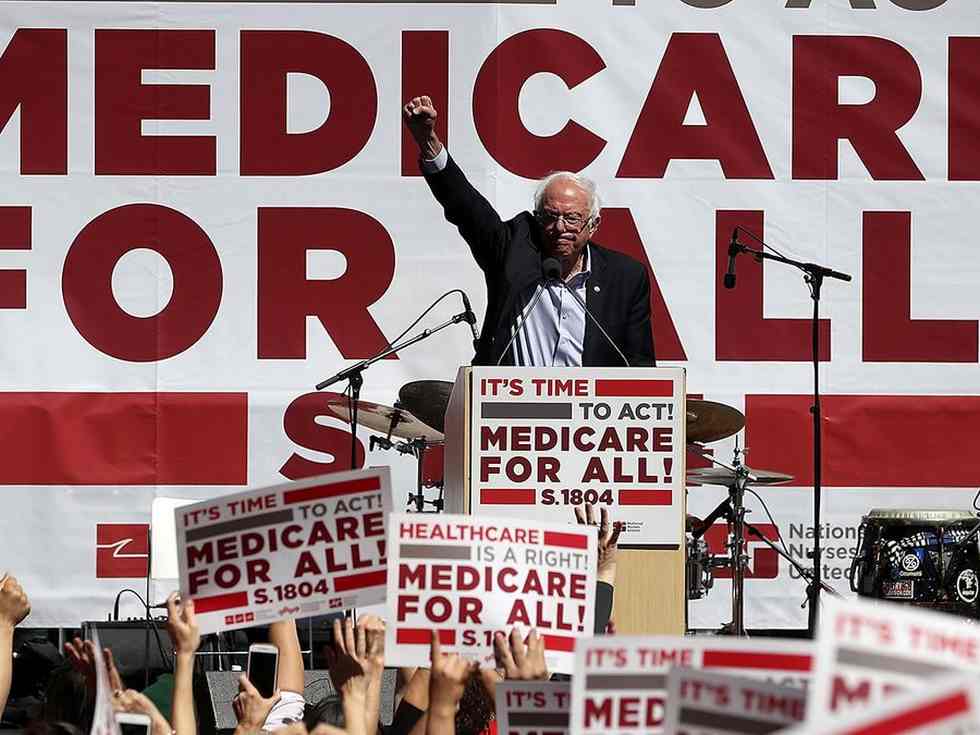
Within the 2016 presidential race, Senator Bernie Sanders (I-Vermont) was the primary candidate to drift the concept of "Medicare for All," a large growth of the favored government-funded well being program to cowl all Individuals, not simply these 65 and older. Whereas hailed by Sanders’ progressive supporters, the proposal failed to achieve traction with mainstream Democratic voters and was ridiculed as a wildly costly "socialist" takeover by Republican critics.
However because the crowded discipline of 2020 Democratic hopefuls dwindles from 20 to 11 official candidates (together with the 78-year-old Sanders), Medicare for All could also be getting a wider listening to. In line with a January ballot from the Kaiser Household Basis, 56 % of Individuals (together with 24 % of Republicans) supported the creation of a "nationwide well being plan." These percentages are just about unchanged since June 2017 however Sanders is now not the one congressperson attempting to cross complete Medicare for All laws.
In February 2019, Consultant Pramila Jayapal (D-Washington) and progressive colleagues within the U.S. Home of Representatives launched their very own Medicare for All Act of 2019, which fits even farther than Sanders’ authentic 2017 invoice. Not solely would the Jayapal proposal do away fully with non-public medical health insurance and require completely no premiums or co-pays of any variety, it might considerably prolong Medicare to cowl complete dental, imaginative and prescient and long-term care.
"Our invoice will cowl everybody. Not simply those that are lucky sufficient to have employer-sponsored insurance coverage. Not simply youngsters. Not simply seniors. Not simply those that are wholesome," wrote Jayapal in a press release. "It is time to make sure that well being care is a proper and never a privilege, assured to each single individual in our nation. It’s time for Medicare for All." (Subcommittee hearings on this invoice have been held in December.)
What ‘Medicare for All’ Is
Medicare was created in 1965 as a security internet medical health insurance program for older Individuals. All Individuals over 65 years outdated qualify for Medicare well being protection no matter preexisting circumstances, and Medicare covers a good portion of the prices of physician’s workplace visits, remedies and surgical procedures, and prescription medicines, though Medicare recipients additionally pay annual premiums and out-of-pocket prices.
Medicare for All proposals like Jayapal’s would make three monumental adjustments to the present Medicare system:
- First, there could be completely no age restrict — each American from newborns to centenarians could be lined by the identical government-funded medical health insurance.
- Second, non-public medical health insurance carriers could be barred from providing plans that compete with Medicare for All. That doubtlessly spells doom for the $1.2 trillion non-public medical health insurance trade.
- Third, sufferers would pay completely nothing — no premiums, deductibles, co-pays, co-insurance — for all lined well being care companies, which below the Jayapal invoice embrace nearly every little thing below the solar, together with costly long-term care insurance coverage to cowl nursing house stays.
Karen Pollitz, who research well being care reform and personal medical health insurance for the Henry J. Kaiser Household Basis (KFF), jokes that Medicare for All would put her out of enterprise.
"The ‘Medicare for All’ proposals which were mentioned are very complete, would cowl every little thing you are used to having lined in non-public medical health insurance right this moment plus dental, imaginative and prescient, listening to, long-term care, nursing house care," says Pollitz, who co-authored a 2018 coverage transient on competing Medicare for All schemes. "You’d get this red-white-and-blue Medicare for All card, present that while you go to the physician, and also you’d get taken care of. Easy."
What ‘Medicare for All’ Is not
Medicare for All will not be "socialized medication" like the UK’s Nationwide Well being Service. Below that system, the federal government will not be solely the only real insurer, but it surely additionally runs many of the medical clinics and hospitals. That is not the case below any of the proposed Medicare for All plans, which extra intently resemble Canada’s well being care system (additionally known as Medicare). Docs and hospitals would stay non-public companies, however all insurance coverage protection — and subsequently all reimbursements paid to docs and hospitals — could be supplied by way of Medicare.
Canada’s well being care system, by the best way, does not cowl imaginative and prescient, dental, prescribed drugs or long-term care. These are lined by non-public insurance coverage.
And Who’s Paying for This?
Medicare for All is what’s also referred to as a single-payer well being care system. Technically, the only payer would be the federal authorities, however the place will the federal government get its cash? New taxes, in fact. Not solely revenue taxes, but additionally payroll taxes, company taxes, excise taxes, and many others.
In 2018, Medicare alone value American taxpayers $605 billion, or 15 % of your complete $4.1 trillion federal funds. The projected value of Sanders’ 2017 Medicare for All invoice, which did not embrace costly add-ons like long-term care, is $32 trillion over 10 years.
"That is some huge cash," says Pollitz. "Proper now, the federal authorities and states collectively are paying virtually half of the nation’s well being care invoice. But when all of us cease paying premiums and deductibles and co-pays, there must be a brand new strategy to elevate income."
When Individuals study that the change to Medicare for All would virtually actually imply larger revenue taxes, assist for the nationwide well being care scheme drops by 23 %. However whereas the exorbitant value of Medicare for All is a favourite speaking level of its critics, the numbers are deceiving. Individuals will definitely pay extra in taxes below such a plan, however they are going to pay completely nothing in premiums and different out-of-pocket well being care prices.
"[American households and the government combined] are at the moment spending $3.5 trillion a 12 months on well being care, greater than any nation on the planet," says Pollitz. In case you multiply that out by 10 years, it is $35 trillion, even higher than the price of Sanders’ Medicare for All proposal. So a change to a single-payer system may really get monetary savings general.
Will ‘Medicare for All’ Imply Worse Well being Care?
There isn’t any doubt {that a} large overhaul of the U.S. well being care system like Medicare for All could be massively disruptive. Most non-public insurers would exit of enterprise. Pharmaceutical corporations would lose earnings as drug costs are capped. And since Medicare usually reimburses docs and hospitals at decrease charges than non-public insurers, there could be "winners and losers" in non-public medical practices, says Pollitz.
That mentioned, there isn’t any indication that switching to a Medicare for All system would lead to fewer lined remedies — in actual fact, Jayapal’s proposal guarantees the alternative — or that the brand new insurance coverage scheme would lead to lengthy waits for life-saving procedures and medicines.
"We do not at the moment have that in Medicare," says Pollitz. "You do not see senior residents queuing up for physician’s appointments and prescriptions. It is all fast and simple. The important thing query is what is going to these cost charges be for docs and hospitals. The Jayapal invoice does not actually say. That is nonetheless a key query to be addressed and debated."
Presently, a rising variety of docs do not settle for Medicare sufferers due to the low reimbursement charges and great amount of paperwork required for reimbursement. The Medicare for All Act of 2019 does permit docs and sufferers to decide out of the single-payer system and easily pay in money for medical companies.
Be taught extra about Medicare in "Medicare: The Clear, Concise, Self-Educating Information" by Mario Robertson. HowStuffWorks picks associated titles primarily based on books we expect you will like. Do you have to select to purchase one, we’ll obtain a portion of the sale.
Now That is Attention-grabbing
Jayapal’s plan is just one sort of common well being protection being proposed in Congress. Different variations embrace retaining the present system however including a public choice primarily based on Medicare in addition to permitting older folks not but eligible for Medicare to purchase into the system. Two-thirds of Individuals in a January 2020 ballot favored including a public choice, in distinction to the 56 % who favored Medicare for All.

